Viola septemloba Leconte
Common names:
Southern Coast Violet
Synonyms:
Viola septemloba Leconte, Ann. Lyceum Nat. Hist. New York 2: 141. 1828 ["1826"]. TYPE: "Habitat in Carolina et Georgia in pinetis solum, per tractum quae regio inferior vocatur"; J. E. Leconte, Plate number 5 of Leconte's unpublished watercolors, Call number QK 495 V811 L496f, University of Notre Dame Libraries, Department of Special Collections, Section of Rare Books (LECTOTYPE (designated by Nir Gil-ad. 1997. Boissiera 53: 76): NDG!, ISOLECTOTYPE: K!).
Viola vicinalis Greene, Pittonia 4: 9. 1899 [replacement name for V. insignis Pollard]; Viola insignis Pollard, Bot. Gaz. 26: 334. 1898 [illegitimate homonym of V. ×insignis K.Richt. (1888)]
Description:
Acaulescent rosulate perennials from thick rhizome, ≤ 25 cm tall; foliage commonly somewhat succulent, foliage and peduncles green, lower surface of leaf blades occasionally tinged with purple, glabrous throughout; stipules free, irregularly glandular-fimbriate; heterophyllous, juvenile plants not producing divided leaf blades, reproductive plants with smallest leaf blades undivided, larger blades moderately to deeply pedately or occasionally biternately divided into (3)5 or 7(9) lanceolate or elliptical lobes with rounded apices, the terminal lobe usually distinctly broader than others, the lowest lobe of the lateral primary divisions oriented downward, largest ≤ 45 × 58 mm, outline ovate to broadly ovate, base cordate, margins entire (rarely remotely crenate-serrate), eciliate, apex obtuse; chasmogamous peduncle held above the leaves; chasmogamous flower ≤ 30 mm; calyx glabrous, eciliate; lowest sepals lanceolate, acuminate; auricles short to prominent and entire, elongating to 2.5 mm in fruit; corolla blue to purple, throat white; spur short-globose; lateral petals densely bearded with filiform to narrowly linear hairs, spurred petal densely bearded; cleistogamous flowers produced after chasmogamous, peduncle erect and nearly or quite equaling petioles; capsule 13–18 mm, green drying tan, unspotted, glabrous; seeds (1.5)1.9–2.5 × 1.4–1.6 mm, brownish-black, unspotted; 2n=54.
Similar species:
This heterophyllous species is sometimes confused with V. sagittata (another member of the Sagittata group) and homophyllous cut-leaved Viola brittoniana; the ranges of these three converge on the Coastal Plain, but the local and regional distributions of Viola brittoniana and Viola septemloba are virtually non-overlapping. This differs from V. brittoniana in having subsucculent strictly glabrous gray-green foliage, the earliest and latest leaf blades undivided, cut leaf blades mostly pedately divided with the terminal lobe commonly undivided and broader and longer than the other lobes, the chasmogamous peduncle held above the leaves, often larger flower, and larger brownish-black seeds.
Ecology:
Sandy soils of pine woodlands, especially frequently burned longleaf pine savannas.
Distribution:
Atlantic Coastal Plain and "fall line", and Gulf Coastal Plain, se. VA south to FL, w. to LA.
Rarity:
None.
Phenology:
Chasmogamous flower February–May, chasmogamous fruit April–June, cleistogamous fruit July–October.
Affinities:
This species belongs to the Acaulescent Blue Violet lineage, sect. Nosphinium W.Becker, subsect. Boreali-Americanae (W.Becker) Gil-ad, in the Sagittata species group.
Hybrids:
Hybridizes with V. emarginata sensu stricto (House 1914, Brainerd 1924). Brainerd reported that this exhibits intermediate or recombinant characteristics of foliage, chasmogamous flowers, cleistogamous capsules and seeds (where these did not abort). The species occasionally grows in local sympatry with others (e.g., V. sagittata), and such hybrids should be sought.
Comments:
Brainerd (1921b), Brainerd Baird (1942), Fernald (1950), Alexander (1963), Russell (1965), and Gil-ad (1995, 1997, 1998) accepted the present taxon as a distinct species. Gleason and Cronquist (1991) subsumed it into a very broadly defined V. palmata. McKinney (1992) and McKinney and Russell (2002) merged this and V. egglestonii, recognizing them as varieties of V. septemloba on the basis of similar leaf blade dissection pattern, but Little and McKinney (2015) reinstated the present taxon to species rank. Early on, Brainerd and his contemporaries did not distinguish the present species from V. brittoniana, referring to both as V. septemloba. Additionally, the present species has been frequently confused with V. brittoniana or hybrids of V. brittoniana (especially the hybrid with V. sagittata). These factors have led to a number of erroneous reports of V. septemloba from the northern Atlantic Coastal Plain.
This and another heterophyllous species, V. edulis, exhibit what I have called "delayed heterophylly", in which juvenile and early chasmogamous-flowering individuals often do not produce the divided leaf blades of later reproductive individuals. Populations of this species in particular commonly include reproductive individuals with the largest leaf blades deeply lobed in chasmogamous flower and cleistogamous fruit as well as fully intermixed juvenile plants completely lacking cut leaf blades. Inspection shows that these are typical V. septemloba, but juveniles are sometimes unknowingly segregated as an uncut-leaved species. One of the syntype sheets for the name V. langloisii includes a specimen of V. septemloba with only uncut leaf blades. The extent of leaf dissection in this is quite variable, with individual plants not infrequently producing some 3–lobed blades and others with 5–, 7–, or 9–lobed blades. Brainerd (1911a) discussed this intra-plant and population-level variability in relation to the synonym V. insignis Pollard, distinguished from the present species originally for having merely 3-lobed leaves. Russell's (1965) illustration for V. edulis (which he called V. esculenta) is not the latter but a plant of V. septemloba with 3-lobed leaf blades.
In Brainerd Baird's time the geographic distributions of V. brittoniana and V. septemloba were thought not to overlap at the state level; however, increased botanical surveys and collections have found regional co-occurrence in the Carolinas, where the local range of V. brittoniana shifts up onto the Upper Coastal Plain and adjacent Lower Piedmont into moister organic soils near streams closer to the "fall line", while V. septemloba remains on the Lower and Middle Coastal Plain in its preferred habitat of frequently burned longleaf pine savanna. No hybrids between the two have been reported, but they may be expected in North Carolina. The northern range limit for V. septemloba based on confirmed records has usually been noted as North Carolina, but House (1924) and Brainerd (1924) report a hybrid with V. emarginata from Gilmerton in Norfolk County, Virginia. I have confirmed an old misidentified herbarium specimen of this species at VPI from that area of Virginia. The species was not mentioned by Weakley et al. (2012) but was noted from southeastern Virginia by Ballard et al. (2020). Extant populations of the species should be sought in that area. Winn and Moriuchi (2009) investigated the evolutionary benefits of the chasmogamous-cleistogamous mixed mating system in this species.
Literature Cited:
Alexander, E. J. 1963. Violaceae. In Gleason, H. A., The new Britton and Brown illustrated flora of the northeastern United States and adjacent Canada. Hafner Publishing Co., Inc., New York, NY. 552-567.
Ballard, Jr., H. E., B. A. Sorrie, and A. S. Weakley. 2020. Violaceae. In: Weakley, A. S. Flora of the southeastern United States. University of North Carolina, Chapel Hill, NC.: 862-878.[https://doi.org/10.1007/s12225-020-9866-6].
Brainerd, E. 1911a. Further notes on the stemless violets of the south. Bulletin of the Torrey Botanical Club 38: 1-9.
Brainerd, E. 1921b. Violets of North America. Vermont Agricultural Experiment Station Bulletin 224: 1-172.
Brainerd, E. 1924. The natural violet hybrids of North America. Vermont Agricultural Experiment Station Bulletin 239.
Brainerd Baird, V. 1942. Wild violets of North America. University of California Press, Berkeley, CA.
Fernald, M. L. 1950. Violaceae. In Gray’s Manual of Botany, 8th ed. American Book Company, New York, NY. 1022-1042.
Gil-ad, N. L. 1995. Systematics and evolution of Viola L. subsection Boreali-Americanae (W. Becker) Brizicky. Ph.D. dissertation. University of Michigan, Ann Arbor, MI.
Gil-ad, N. L. 1997. Systematics of Viola subsection Boreali-Americanae. Boissiera 53: 1-130.
Gil-ad, N. L. 1998. The micromorphologies of seed coats and petal trichomes of the taxa of Viola subsect. Boreali-Americanae (Violaceae) and their utility in discerning orthospecies from hybrids. Brittonia 50: 91-121.
Gleason, H. A., and A. Cronquist. 1991. Violaceae. In Manual of vascular plants of northeastern United States and adjacent Canada, 2nd ed. New York Botanical Garden, Bronx, NY. 157-163.
House, H. D. 1914. Violets new to southeastern Virginia. Torreya 14: 2-4.
Little, R. J., and L. E. McKinney. 2015. Violaceae. In Flora of North America: Cucurbitaceae to Droseraceae, 106. Oxford University Press, New York, NY.
McKinney, L. E. 1992. A taxonomic revision of the acaulescent blue violets (Viola) of North America. Sida, Botanical Miscellany 7: 1-60.
McKinney, L. E., and N. H. Russell. 2002. Violaceae of the southeastern United States. Castanea 67: 369-379.
Russell, N. H. 1965. Violets (Viola) of the central and eastern United States: An introductory survey. Sida 2: 1-113.
Weakley, A. S., J. C. Ludwig, and J. F. Townsend. 2012. Violaceae. In Flora of Virginia. BRIT Press, Fort Worth, TX. 963-975.
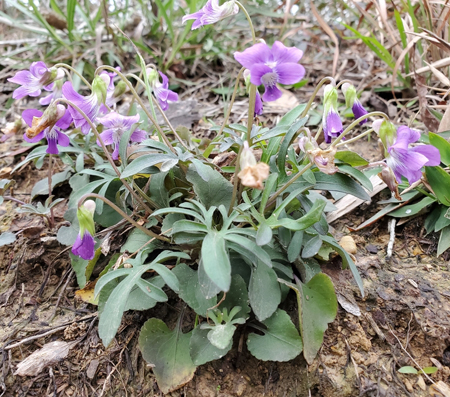
Chasmogamous flowering habit (along dusty roadside) by M. C. Willy, "iNaturalist" website", under Creative Commons licence CC BY-NC 4.0
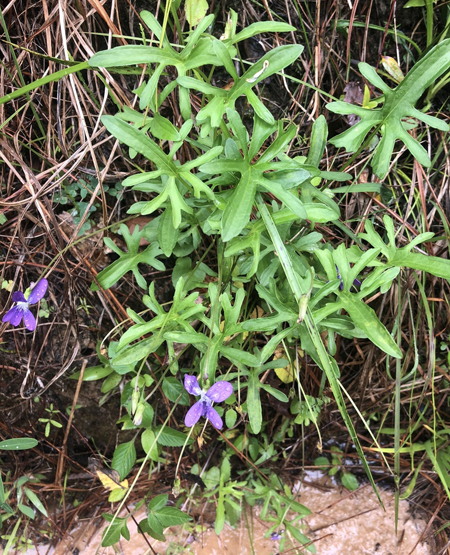
Chasmogamous flowering habit by Brian Keener, "iNaturalist" website", under Creative Commons licence CC BY-NC 4.0
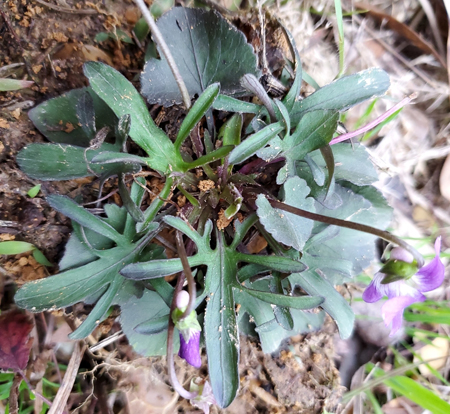
Leaves during chasmogamous flower by M. C. Willy, "iNaturalist" website", under Creative Commons licence CC BY-NC 4.0
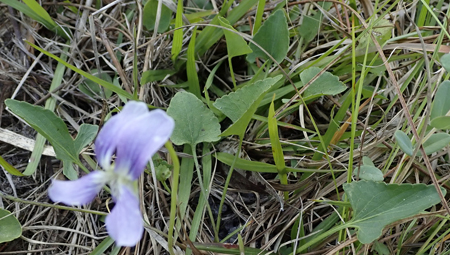
Leaves during chasmogamous flower by mitomi68, "iNaturalist" website", under Creative Commons licence CC BY-NC 4.0

Leaves during chasmogamous flower by Old Bean Adams, "iNaturalist" website", under Creative Commons licence CC BY-NC 4.0

Leaf (rare biternate phenotype) during chasmogamous flower by Jessica McAlpine, "iNaturalist" website", under Creative Commons licence CC BY-NC 4.0

Chasmogamous flower front view by Old Bean Adams, "iNaturalist" website", under Creative Commons licence CC BY-NC 4.0
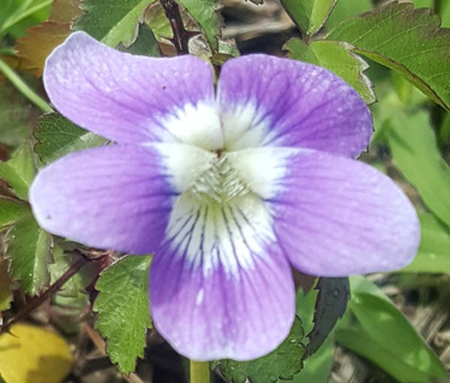
Chasmogamous flower front view by Tess the Naturalist, "iNaturalist" website", under Creative Commons licence CC BY-NC 4.0

Chasmogamous flower profile view by M. C. Willy, "iNaturalist" website", under Creative Commons licence CC BY-NC 4.0
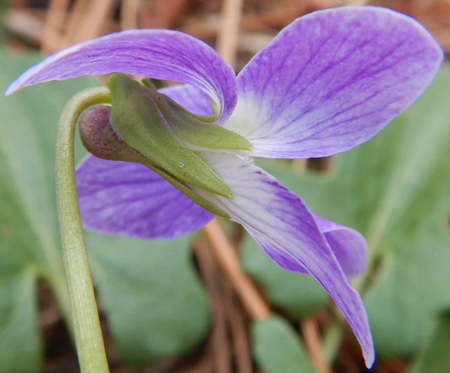
Chasmogamous flower profile view by Old Bean Adams, "iNaturalist" website", under Creative Commons licence CC BY-NC 4.0
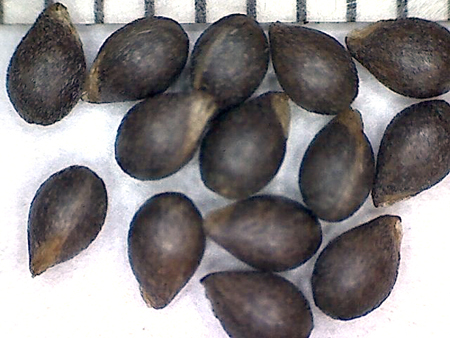
Seeds from herbarium specimen: Transplanted from NC, Brunswick Co., Big Island Savanna, plant Y, H. Ballard 15-002 and A. Stuart (BHO)

Map by the Biota of North America Program